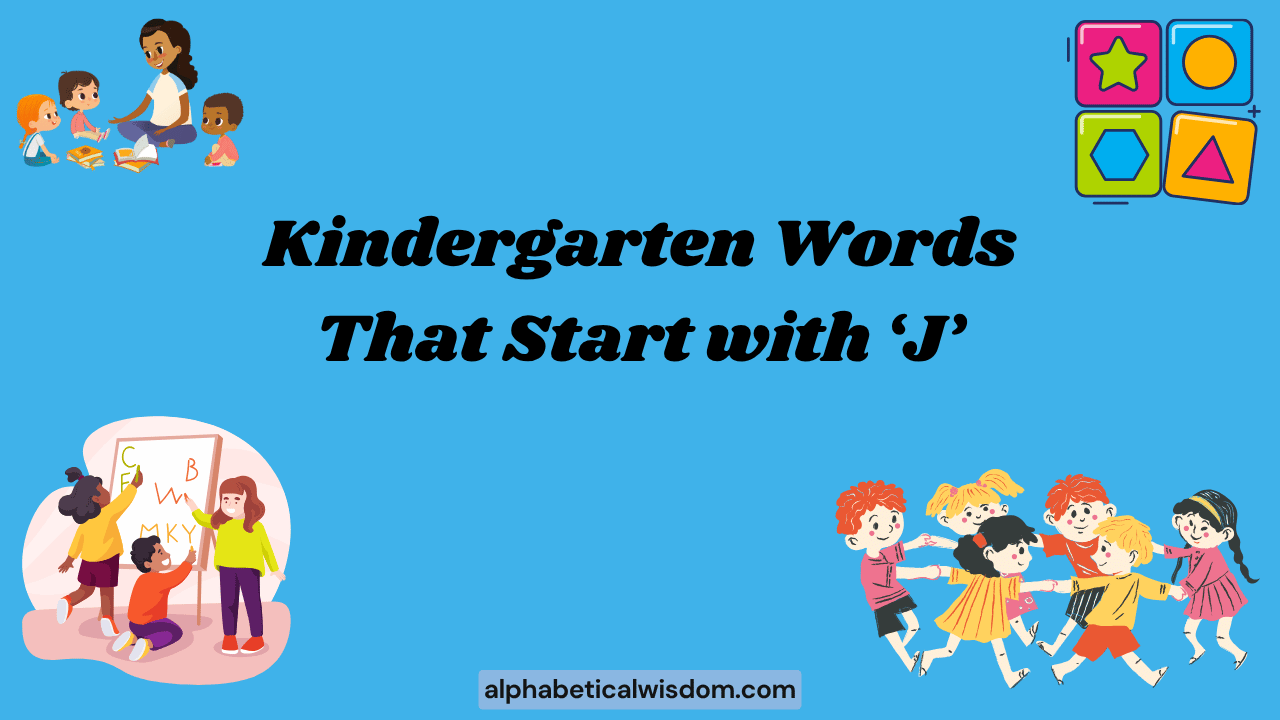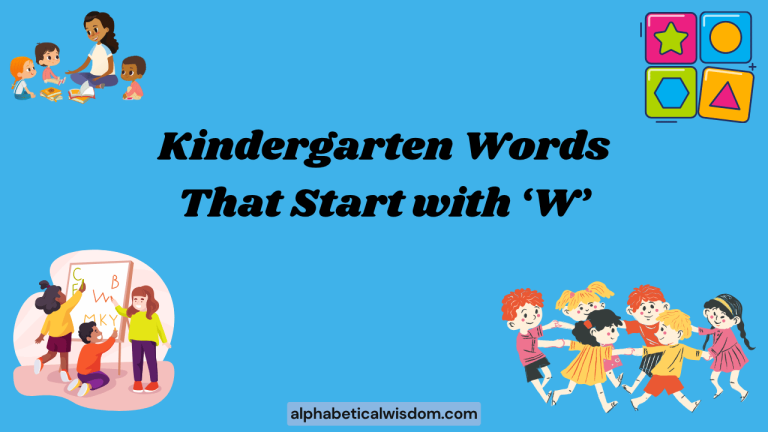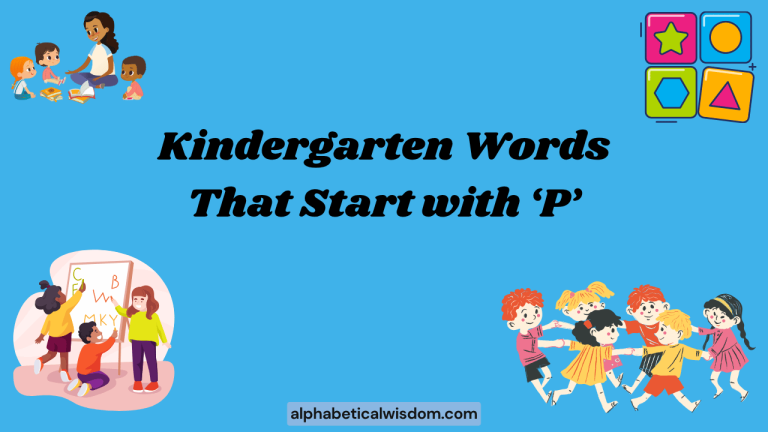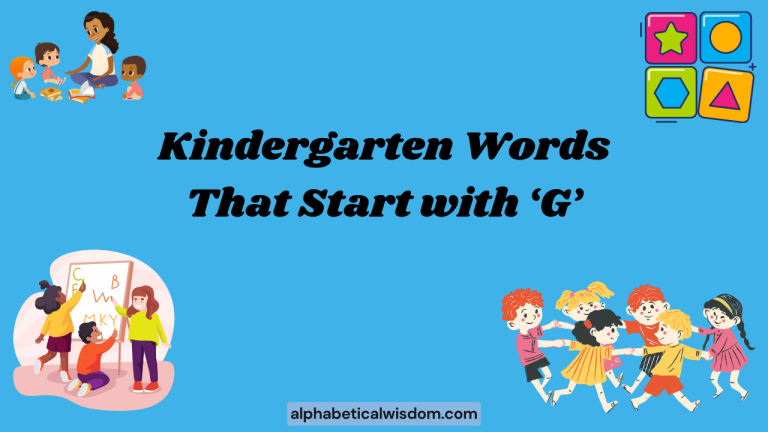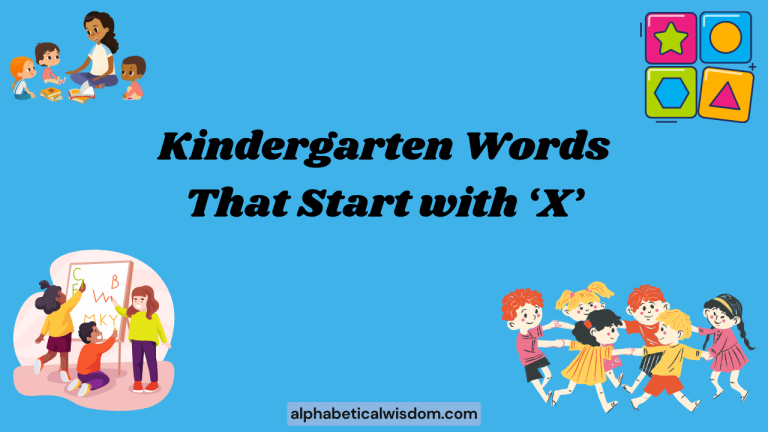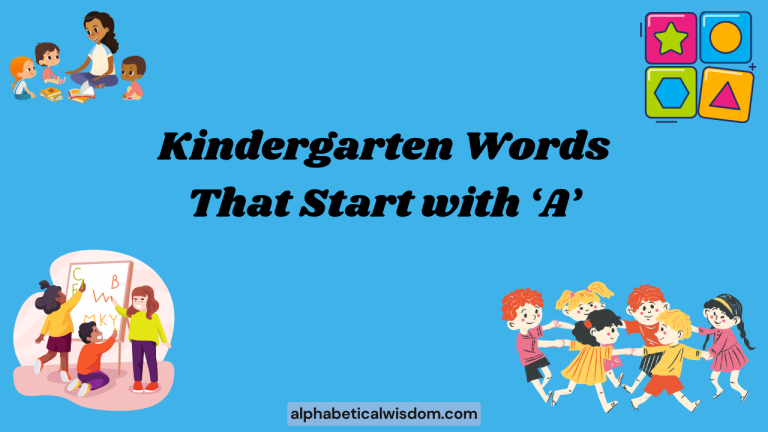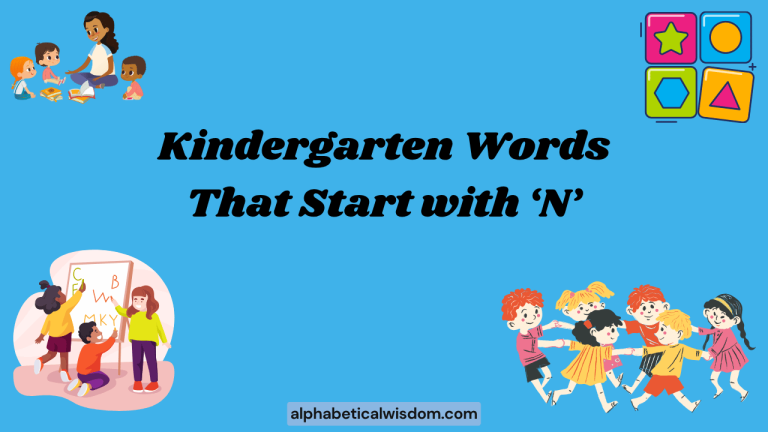Kindergarten Words That Start With J: A Comprehensive Guide
Learning new words is a fundamental part of a child’s early education. Words that start with the letter “J” are particularly engaging for kindergarteners, as they often introduce fun and exciting concepts.
This article provides a detailed exploration of these words, covering their definitions, usage, and ways to practice them. Understanding these words not only enhances vocabulary but also improves reading comprehension and overall language skills.
This guide is perfect for parents, teachers, and anyone involved in early childhood education, providing a structured approach to vocabulary development.
Mastering these simple words sets a strong foundation for future learning, encouraging children to explore the world of language with confidence and enthusiasm. By incorporating these words into daily activities and lessons, educators and parents can foster a love of reading and writing from a young age.
This comprehensive guide offers the tools and insights needed to make learning both effective and enjoyable.
Table of Contents
- Introduction
- Definition of Kindergarten Words That Start With J
- Structural Breakdown of Words Starting With J
- Types and Categories of J-Words for Kindergarten
- Examples of Kindergarten Words That Start With J
- Usage Rules for J-Words
- Common Mistakes When Using J-Words
- Practice Exercises
- Advanced Topics: Expanding J-Word Vocabulary
- Frequently Asked Questions
- Conclusion
Definition of Kindergarten Words That Start With J
Kindergarten words that start with the letter “J” are simple, age-appropriate terms designed to introduce young children to the English language. These words typically refer to common objects, actions, or qualities that are easily understood and relatable to a kindergartener’s everyday experiences.
The primary function of these words is to build a basic vocabulary, enhance early reading skills, and improve communication abilities. These words are often introduced through picture books, flashcards, and interactive games to make learning engaging and effective.
The classification of these words usually falls into three main categories: nouns (naming words), verbs (action words), and adjectives (describing words). For instance, jar is a noun, jump is a verb, and jolly is an adjective. Understanding these classifications helps children grasp the different roles words play in forming sentences and expressing ideas. The context in which these words are used is crucial; for example, “The girl wears a jacket” provides a context for understanding what a jacket is and how it is used.
The importance of these words in early childhood education cannot be overstated. They serve as building blocks for more complex vocabulary and grammar, enabling children to express themselves more clearly and confidently.
By mastering these foundational words, kindergarteners develop a strong base for future academic success and effective communication.
Structural Breakdown of Words Starting With J
Words starting with the letter “J” follow standard English phonetic rules, but the “J” sound itself is unique. The letter “J” typically produces a /dʒ/ sound, as in jam or jet. This sound is a voiced postalveolar affricate, meaning it involves both a stop and a fricative component produced near the alveolar ridge. Understanding this sound helps children with pronunciation and spelling.
The structural elements of J-words are similar to other English words. They consist of a combination of consonants and vowels that create recognizable syllables. For example, the word jacket has two syllables: “jack” and “et.” Recognizing syllable patterns helps children break down longer words into manageable parts, improving their reading fluency. Many J-words are relatively short, making them easier for young learners to decode and remember. Common patterns include CVC (consonant-vowel-consonant) like jet and CVCE (consonant-vowel-consonant-e) like jape, although CVCE words are less common in kindergarten vocabulary.
Morphological analysis, while less relevant for simple kindergarten words, can still be introduced at a basic level. For example, adding “-ing” to the verb jump to form jumping demonstrates a simple morphological change. Understanding these basic structural principles lays the groundwork for more advanced linguistic concepts later in their education.
Types and Categories of J-Words for Kindergarten
Nouns
Nouns are words that name people, places, things, or ideas. J-nouns commonly introduced in kindergarten include objects like jar, jacket, and juice, as well as concepts like joy. These words help children identify and categorize the world around them, forming a crucial part of their early vocabulary.
Understanding the difference between common and proper nouns can also be introduced at a basic level. Common nouns refer to general items (e.g., jacket), while proper nouns refer to specific people or places (e.g., January, if applicable). Recognizing these distinctions builds a deeper understanding of noun usage.
Verbs
Verbs are words that describe actions or states of being. J-verbs commonly taught in kindergarten include jump, jog, and join. These words help children express movement and activity, enhancing their ability to describe what they and others are doing.
Simple verb tenses, such as present tense (jump) and present continuous tense (jumping), can be introduced to show how verbs change based on time. This helps children understand the concept of timing and sequence in their language.
Adjectives
Adjectives are words that describe nouns, providing more information about their qualities or characteristics. J-adjectives for kindergarteners might include jolly, joyful, and jumbo. These words help children express feelings, sizes, and other descriptive details, enriching their language and communication skills.
Introducing comparative adjectives, such as jumbo (larger than usual), can help children understand comparisons and degrees of qualities. This lays the foundation for more complex adjective usage in later grades.
Examples of Kindergarten Words That Start With J
Providing concrete examples is essential for helping kindergarteners understand and remember new words. The following sections offer extensive examples of J-words categorized by nouns, verbs, and adjectives, presented in tables for easy reference.
Examples of Nouns
The following table provides a list of J-nouns suitable for kindergarteners, along with example sentences to illustrate their usage. This list is designed to be comprehensive and varied, covering a range of common objects and concepts.
| Noun | Example Sentence |
|---|---|
| Jar | The jar is full of cookies. |
| Jacket | She wears a warm jacket in winter. |
| Juice | He likes to drink orange juice. |
| Jewel | The queen has a shiny jewel. |
| Jam | I spread strawberry jam on my toast. |
| Jet | The jet flies very fast. |
| Jelly | We had jelly for dessert. |
| Joke | He told a funny joke. |
| Joy | She felt great joy when she got a puppy. |
| Judge | The judge listens to the case. |
| Jug | The jug is filled with water. |
| Jingle | We heard the jingle of the bells. |
| Journey | They went on a long journey. |
| Joint | He has pain in his joint. |
| Journal | She writes in her journal every day. |
| Juniper | The juniper tree smells nice. |
| Javelin | The athlete threw the javelin. |
| Jamboree | They had a fun jamboree. |
| Jasper | She found a jasper stone. |
| Janitor | The janitor cleans the school. |
| Jester | The jester told a funny joke. |
| Jodhpur | He wore jodhpurs for riding. |
| Jot | He made a quick jot in his notebook. |
| Jowl | The dog has a floppy jowl. |
| Jukebox | They played music on the jukebox. |
| Julienne | He cut the vegetables julienne. |
| Jumble | There was a jumble of toys on the floor. |
| Jumpsuit | She wore a stylish jumpsuit. |
| Junk | He threw away the old junk. |
| Jurisdiction | The court has jurisdiction over the case. |
Examples of Verbs
The following table presents a selection of J-verbs suitable for kindergarteners, along with example sentences to illustrate their usage. These verbs are chosen to represent common actions and activities that children can easily relate to.
| Verb | Example Sentence |
|---|---|
| Jump | The children jump on the trampoline. |
| Jog | He likes to jog in the park. |
| Join | She will join the club next week. |
| Jiggle | The jelly will jiggle. |
| Juggle | The clown can juggle three balls. |
| Jest | The jester jests to make people laugh. |
| Jab | He jabbed the button to start the machine. |
| Jazzed | She jazzed up her outfit with a scarf. |
| Jeopardize | Don’t jeopardize your safety. |
| Jerking | The car was jerking along the bumpy road. |
| Jet | The plane will jet off soon. |
| Jettison | They had to jettison cargo to lighten the load. |
| Jibed | Their stories jibed perfectly. |
| Jinx | Don’t jinx our winning streak! |
| Jitterbug | They jitterbugged at the dance. |
| Job | She needs to job out the details. |
| Jockey | The riders jockeyed for position. |
| Joggle | The baby joggled in his seat. |
| Join | He will join us for dinner. |
| Joke | She likes to joke around with her friends. |
| Jolt | The thunder jolted him awake. |
| Jostle | People jostled in the crowd. |
| Jounce | The car jounced over the potholes. |
| Journal | She will journal her thoughts every day. |
| Journey | They will journey to a faraway land. |
| Judged | The contest was judged by experts. |
| Juggle | He can juggle many things at once. |
| Juice | She will juice the oranges for breakfast. |
| Jumble | He will jumble all the pieces together. |
| Jumpstart | He will jumpstart the car. |
Examples of Adjectives
The following table offers a range of J-adjectives suitable for kindergarteners, along with example sentences to illustrate their usage. These adjectives are chosen to help children describe qualities and characteristics in a simple and relatable way.
| Adjective | Example Sentence |
|---|---|
| Jolly | Santa Claus is a jolly man. |
| Joyful | She is having a joyful day. |
| Jumbo | That is a jumbo sized elephant. |
| Jagged | The rocks have jagged edges. |
| Jaunty | He wore a jaunty hat. |
| Jealous | She felt jealous of her friend’s new toy. |
| Jeering | The jeering crowd made him nervous. |
| Jejune | His ideas were jejune and immature. |
| Jelled | The plans have jelled nicely. |
| Jesting | He was in a jesting mood. |
| Jet | The jet black cat is very sleek. |
| Jettisoned | The jettisoned cargo floated in the sea. |
| Jeweled | She wore a jeweled crown. |
| Jiggling | The jiggling dessert looked delicious. |
| Jingoistic | His views were very jingoistic. |
| Jobless | The jobless man was looking for work. |
| Jocose | He had a jocose attitude. |
| Jocund | The party was filled with jocund music. |
| Jogging | The jogging man ran past the park. |
| Joint | It was a joint effort. |
| Joking | He made a joking remark. |
| Jolting | The jolting ride made him sick. |
| Jolly | The jolly man laughed loudly. |
| Journalistic | He had a journalistic approach to the story. |
| Journeying | The journeying travelers were tired. |
| Judicious | He made a judicious decision. |
| Jugular | He felt a jugular pressure. |
| Juicy | The juicy orange was delicious. |
| Jumbled | The jumbled mess was hard to sort. |
| Jumping | The jumping frog was quick. |
Usage Rules for J-Words
The usage rules for J-words in kindergarten are relatively straightforward. The key is to ensure that children understand the basic function of each word and how it fits into a simple sentence.
Here are some general guidelines:
- Nouns: Use nouns to name objects, people, or places. Ensure the noun agrees in number with the verb (e.g., “The jar is full,” not “The jar are full”).
- Verbs: Use verbs to describe actions. Pay attention to verb tense to indicate when the action is happening (e.g., “I jump,” “I am jumping“).
- Adjectives: Use adjectives to describe nouns. Place the adjective before the noun it modifies (e.g., “a jolly man,” not “a man jolly”).
Exceptions to these rules are rare at the kindergarten level, but it’s important to address them as they arise. For example, some J-words may have multiple meanings, and the context will determine the correct usage.
Understanding these nuances comes with practice and exposure to a wide range of examples.
Special cases might include compound words (though rare for kindergarten J-words) or idiomatic expressions. However, the focus should remain on building a solid foundation in basic grammar and vocabulary.
Common Mistakes When Using J-Words
Even with simple vocabulary, kindergarteners can make common mistakes. Addressing these errors directly helps reinforce correct usage and prevent bad habits from forming.
| Incorrect Example | Correct Example | Explanation |
|---|---|---|
| “I have a juice apple.” | “I have apple juice.” | Incorrect word order. Adjectives typically precede the noun. |
| “He jump yesterday.” | “He jumped yesterday.” | Incorrect verb tense. Use the past tense “jumped” for actions in the past. |
| “The jacket are red.” | “The jacket is red.” | Incorrect subject-verb agreement. “Jacket” is singular, so use “is.” |
| “Joyful am I.” | “I am joyful.” | Incorrect sentence structure. Subject-verb-object order is typical in English. |
| “Jar the big.” | “The big jar.” | Incorrect word order. The adjective should precede the noun. |
| “I joining the team.” | “I am joining the team.” | Missing auxiliary verb. “Am” is needed for the present continuous tense. |
| “She is jolly a girl.” | “She is a jolly girl.” | Incorrect word order. The adjective should come before the noun. |
| “He juggled the ball good.” | “He juggled the ball well.” | “Good” is an adjective, “well” is an adverb to describe the verb. |
| “They is jump.” | “They are jumping.” | Incorrect subject-verb agreement and tense. |
| “I want a juice.” | “I want some juice.” | “Juice” is uncountable, so use “some.” |
By explicitly correcting these common mistakes, teachers and parents can help children develop a stronger grasp of J-word usage and overall grammar.
Practice Exercises
Reinforcing learning through practice is crucial. The following exercises are designed to help kindergarteners practice using J-words in different contexts.
Each exercise includes a set of questions and answers to provide immediate feedback.
Exercise 1: Fill in the Blanks
Instructions: Fill in the blank with the correct J-word from the word bank.
| Question | Word Bank | Answer |
|---|---|---|
| The _____ is full of cookies. | (jacket, jar, juice) | jar |
| She wears a warm _____ in winter. | (juice, jacket, jam) | jacket |
| He likes to drink orange _____. | (jam, juice, jewel) | juice |
| He likes to _____ on the trampoline. | (jog, jump, join) | jump |
| She will _____ the club next week. | (jump, jog, join) | join |
| Santa Claus is a _____ man. | (jolly, jumbo, jagged) | jolly |
| The rocks have _____ edges. | (jolly, jagged, joyful) | jagged |
| She is having a _____ day. | (jumbo, jolly, joyful) | joyful |
| That is a _____ sized elephant. | (jumbo, jolly, jagged) | jumbo |
| I spread strawberry _____ on my toast. | (jet, jam, jewel) | jam |
Exercise 2: True or False
Instructions: Read each sentence and decide if it is true or false.
| Statement | Answer |
|---|---|
| A jacket is something you drink. | False |
| Joy is a feeling of happiness. | True |
| You can jump over a house. | False |
| Jam is a sweet spread for bread. | True |
| A jet is a type of airplane. | True |
| Jolly means sad. | False |
| Juice comes from fruits. | True |
| Jogging is a type of exercise. | True |
| Jumbo means small. | False |
| A jar is used to hold things. | True |
Exercise 3: Matching
Instructions: Match the word to its definition.
| Word | Definition | Answer |
|---|---|---|
| Jump | A container for storing things. | (c) |
| Jacket | A sweet spread made from fruit. | (e) |
| Jar | To move upwards suddenly. | (a) |
| Jam | Clothing worn to keep warm. | (b) |
| Juice | Liquid from fruits or vegetables. | (d) |
- To move upwards suddenly.
- Clothing worn to keep warm.
- A container for storing things.
- Liquid from fruits or vegetables.
- A sweet spread made from fruit.
These exercises provide a variety of ways for kindergarteners to practice using J-words, reinforcing their understanding and retention.
Advanced Topics: Expanding J-Word Vocabulary
For advanced kindergarteners or those ready for a challenge, introducing more complex J-words can further enhance their vocabulary. These words might include terms like justify, jeopardy, or jubilant. When introducing these words, it’s important to provide clear definitions and contextual examples to aid comprehension.
Exploring the etymology of J-words can also be a fascinating exercise. For example, tracing the origins of words like journey or judge can provide insights into language history and cultural connections. While this is advanced for kindergarteners, it can spark curiosity and a deeper appreciation for language.
Another advanced topic is exploring the use of J-words in idioms and expressions. Phrases like “jumping for joy” or “a jewel in the crown” add color and nuance to language, and introducing them can help children understand the figurative use of words.
Frequently Asked Questions
- Why is it important for kindergarteners to learn words starting with “J”?
Learning words starting with “J” expands their vocabulary, improves reading skills, and enhances communication abilities. It forms a foundation for future learning and academic success.
- What are some easy J-words for kindergarteners to learn?
Easy J-words include jar, jacket, juice, jump, and jolly. These words are simple, relatable, and commonly used in everyday contexts.
- How can I make learning J-words fun for my child?
Use flashcards, picture books, and interactive games. Incorporate the words into daily activities and storytelling to make learning engaging and memorable.
- What should I do if my child struggles to pronounce J-words?
Break the words into syllables and practice the /dʒ/ sound. Use online resources and pronunciation guides to help them hear and repeat the words correctly.
- Are there any specific strategies for teaching J-words to visual learners?
Use visual aids such as colorful illustrations, flashcards with pictures, and videos. Connect the words to real-life objects and experiences to reinforce learning.
- How can I assess my child’s understanding of J-words?
Use simple quizzes, fill-in-the-blank exercises, and storytelling activities. Ask them to use the words in sentences and explain their meanings.
- Can learning J-words help with other subjects, like reading and writing?
Yes, a strong vocabulary is essential for reading comprehension and writing skills. Knowing J-words helps children understand and express themselves more effectively.
- What are some common mistakes kindergarteners make with J-words, and how can I correct them?
Common mistakes include incorrect word order, verb tense errors, and subject-verb agreement issues. Provide clear explanations and practice exercises to reinforce correct usage.
- How do I introduce the concept of nouns, verbs, and adjectives using J-words?
Explain that nouns name things, verbs describe actions, and adjectives describe qualities. Use J-words as examples to illustrate these concepts (e.g., jar is a noun, jump is a verb, jolly is an adjective).
- Where can I find more resources for teaching J-words to kindergarteners?
Many websites, educational apps, and children’s books offer resources for vocabulary development. Look for materials specifically designed for early childhood education.
Conclusion
Mastering kindergarten words that start with the letter “J” is a crucial step in a child’s early education. By building a solid foundation in vocabulary, teachers and parents can empower young learners to communicate effectively, understand written language, and develop a lifelong love of learning.
This guide has provided a comprehensive overview of J-words, covering their definitions, usage, and ways to practice them.
Remember to make learning fun and engaging by using a variety of teaching methods, such as games, stories, and visual aids. Regularly assess your child’s progress and provide feedback to reinforce their understanding.
With consistent effort and encouragement, kindergarteners can confidently expand their vocabulary and achieve academic success.
Ultimately, the goal is to equip children with the language skills they need to explore the world around them and express their thoughts and ideas with clarity and confidence. By focusing on foundational words like those starting with “J,” we can help them build a strong base for future learning and communication.
